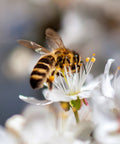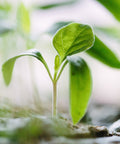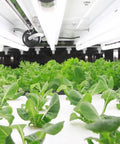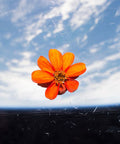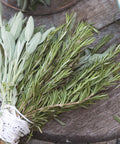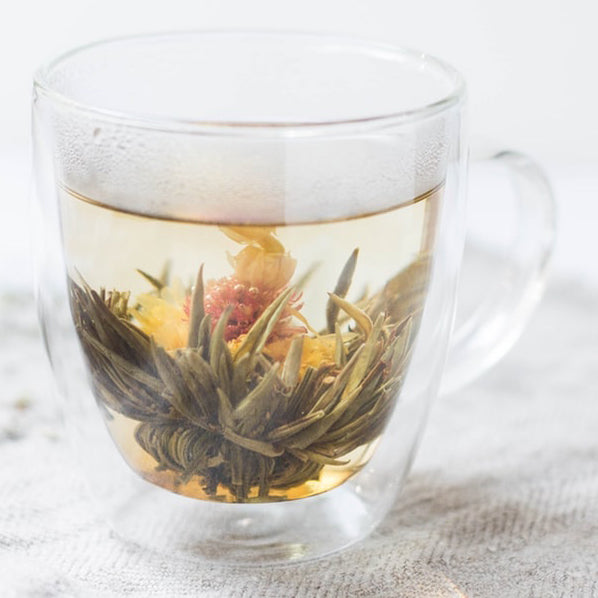
One of the best ways to enjoy fresh homegrown herbs are in herbal teas. Herbal teas can be made using various parts of a plant such as the leaves, flowers, seeds, or even the roots and is a relatively simple task to make. Whichever herb you decide to brew a cup of, the process involves pouring boiling water over your choice of herbs and steeping until your desired flavor is reached. Don't be shy to branch out and mix several herb combinations to create your own herbal infusions.
Whether you want to make an herbal tea with the herbs grown in your ēdn SmallGarden or you're looking to start your own herbal tea garden in your windowsill, below are some of our favorite herbs we recommend you try steeping up the next time you’re craving a fresh cup of tea:
Basil

Basil makes a refreshing cup of tea thanks to its bracing flavor. Basil tea has a variety of health benefits: it can reduce stress, freshen breath, lower blood sugar levels, and even ease heart disease. When mixed with honey and ginger, basil can relieve various respiratory conditions including asthma, the common cold, and influenza.
To brew fresh: Pinch off a couple of leaves per cup and steep for several minutes.
To brew dried: Place about a teaspoon of dried leaves in a tea infuser and steep for several minutes.
Catnip

Catnip is a member of the mint family that is famous for its stimulant effects on cats. Paradoxically, it has the opposite effect on humans. People use catnip tea as a sedative, sleep aid and headache remedy. The tea has a mild and pleasant flavor and can be made from the leaves or flowers.
To brew fresh: Pinch off a couple of leaves per cup and steep for several minutes.
To brew dried: Place about a teaspoon of dried leaves in a tea infuser and steep for several minutes.
Chamomile

Chamomile tea is famous for its calming qualities and many people drink it before bed. Its fruity, apple like flavor is great to consume after dinner to please your taste buds. Adding honey can heighten the tea’s soothing effects.
To brew fresh: Pinch off about two teaspoons of flower heads per cup and steep for 10 minutes.
To brew dried: Place about two teaspoon of dried flower heads in a tea infuser and steep for 10 minutes.
Fennel

Fennel tastes like licorice and it has a soothing, warm quality. Fennel in any form is thought to aid digestion and is great to add to any herbal tea combination.
To brew leaves: Pinch off several fronds of leaves, slightly crushing them prior to placing them in the cup and steeping for several minutes.
To brew seeds: Place about a teaspoon of seeds in a tea infuser and steep for several minutes.
Lavender

Lavender has a powerful flowery aroma that is believed to relieve insomnia and promote relaxation. Like chamomile, it’s a great tea to drink in the evening before bed.
To brew fresh: Pinch of several flower buds and steep for about 5 minutes to release the aroma.
To brew dried: Place several teaspoons of dried flower buds in a tea infuser and steep for about 5 minutes to release the aroma.
Mint

There are many types of mint, which all have a variety of invigorating flavors and aromas. In addition to spearmint and peppermint, mint can also take on flavors like chocolate, orange, and many others. While fresh leaves are the most flavorful, dried leaves retain flavor longer.
To brew fresh: Pinch of a few mint leaves and steep to taste - crush leaves prior to adding water for extra flavor.
To brew dried: Place about a teaspoon of dried leaves in a tea infuser and steep to taste.
Lemon Balm

Lemon balm is a relative of mint, and it combines the coolness of mint with the sharpness of lemon. The tea can relieve an upset stomach, improve memory, reduce stress, and aid sleep, which makes it a good drink to have right before bedtime. Fresh leaves usually work best, but dried leaves can produce a more herbal taste.
To brew fresh: Pinch of several leaves and steep to taste - crush leaves prior to adding water for extra flavor.
To brew dried: Place about a teaspoon of dried leaves in a tea infuser and steep to taste.
Rosemary

Rosemary has a strong flavor and aroma, and the resulting tea can be quite pungent. You can use a teaspoon of dry or fresh leaves to make a cup of tea. Rosemary doesn’t take long to steep, and you can use a sweetener to make the tea less pungent.
To brew fresh: Pinch off about a teaspoon of fresh fronds per cup and steep for a few minutes, you may need somewhat less if you crushed the leaves beforehand.
To brew dried: Place about a teaspoon of dried leaves in a tea infuser and steep for a few minutes.
Sage

Sage’s herbal flavor is quite pleasant, and the tea helps relieve stress. You can also add pineapple or other complementing fruits to give the tea a fruity flavor.
To brew fresh: Pinch off two teaspoons of fresh leaves and steep for about 5 minutes.
To brew dried: Place one teaspoon of dried leaves either loosely in a cup or in a tea infuser and steep about 5 minutes.
Stevia

Stevia is known as the “sugar plant” and is very sweet. While store-bought stevia is white and in a sugar-like form, the homegrown variety is a green leafy plant. Stevia can also be used as a substitute for sugar in any of the teas and is thus good for people with diabetes.
To brew fresh: Pinch off a few leaves to taste and steep to desired sweetness.
To brew dried: To steep dried stevia, either blend the dried leaves beforehand, or crumble into a tea infuser and steep to desired sweetness.


